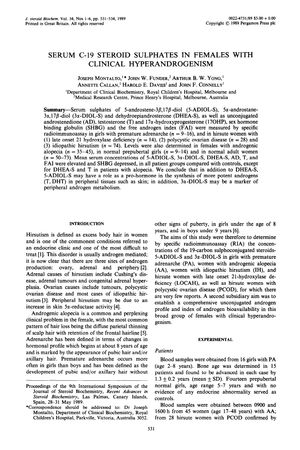Serum C-19 Steroid Sulphates in Females with Clinical Hyperandrogenism
January 1989
in “
Journal of Steroid Biochemistry
”
hyperandrogenism premature adrenarche late onset 21 hydroxylase deficiency polycystic ovarian disease idiopathic hirsutism androgenic alopecia sex hormone binding globulin dehydroepiandrosterone sulphate testosterone 5-androstene-3ß,17ß-diol sulphate 5α-androstane-3α,17ß-diol sulphate androgens peripheral androgen metabolism PA LOCAH PCOD IH AA SHBG DHEA-S T 5-ADIOL-S 3α-DIOL-S

TLDR Women with hyperandrogenism have higher androgen levels and lower SHBG, which may contribute to conditions like excessive hair growth and early puberty.
In a study from 1989, researchers investigated serum levels of androgens and steroid sulphates in females with various forms of hyperandrogenism, including premature adrenarche (PA, n = 9–16), late onset 21 hydroxylase deficiency (LOCAH, n = 14), polycystic ovarian disease (PCOD, n = 28), idiopathic hirsutism (IH, n = 74), and androgenic alopecia (AA, n = 35–45), compared to normal prepubertal girls (n = 9-14) and normal adult women (n = 50–73). The study found elevated levels of certain androgens and a lower level of sex hormone binding globulin (SHBG) in all patient groups except for dehydroepiandrosterone sulphate (DHEA-S) and testosterone (T) in the alopecia group. The study concluded that 5-androstene-3ß,17ß-diol sulphate (5-ADIOL-S) might act as a pro-hormone in the synthesis of more potent androgens in the skin, and that 5α-androstane-3α,17ß-diol sulphate (3α-DIOL-S) could be a marker of peripheral androgen metabolism. These factors seem to play a role in hirsutism and premature pubic hair development in girls, and in androgenic alopecia, 5-ADIOL-S and free testosterone may be particularly significant.






